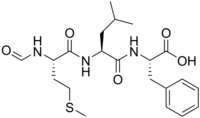N-Formylmethionine-leucyl-phenylalanine
These oligopeptides are known to be, or mimic the actions of, the N-formyl oligopeptides that are (a) released by tissue bacteria, (b) attract and activate circulating blood leukocytes by binding to specific G protein coupled receptors on these cells, and (c) thereby direct the inflammatory response to sites of bacterial invasion.
Peter Ward, Elmer Becker, Henry Showell, and colleagues showed that these elements were made by a variety of growing gram positive bacteria and gram negative bacteria and were of low molecular weight, i.e. below 3600 Dalton (unit)s.[6][7][8] Further studies by Schiffmann and colleges found that cultures of growing Escherichia coli released oligopeptides of between 150 and 1500 daltons that appeared to have a free Carboxylic acid group but not a free Amine group.
[9] Given these clues and knowledge that bacteria transcribe (see Transcription (genetics)) proteins starting with N-formylmethionine whereas eukaryotic cells mostly initiate protein synthesis with non-formylated methionine, Schiffmann, Corcoran, and Wahl theorized and then showed that N-formyl-methionine and a series N-formyl-methionyl dipeptides and tripeptides stimulated the chemotaxis of neutrophils isolated from rabbit peritoneal exudates as well as of macrophages isolated from guinea pig peritoneal exudates.
[7] fMLF and a sampling of other, less potent, N-formyl oligopeptides were then found to stimulate a wide array of rabbit neutrophil functions such as: the transient auto-aggregation of these cells in suspension[11] and equally transient fall in circulating neutrophils when injected into rabbit veins (these responses result from an increase in neutrophil adhesiveness to each other and/or vascular endothelium);[12] the release (see degranulation) of intracellular granule-bound enzymes and other antimicrobial cytotoxic molecules; and the production and release of cytotoxic reactive oxygen species such as Superoxide and hydrogen peroxide.
Follow-up studies found that the genes of mitochondria and chloroplasts organelles of Eukaryote cells, including those of humans, which, unlike nuclear genes, code for N-formyl-methionine proteins, release N-formyl-methionyl containing peptides with chemotactic activities that exactly mimic those of fMLF chemotaxis[14] These organelle-derived formylated peptides are true analogs of fMLF that operate through fMLF receptors to recruit circulating blood leukocytes to and thereby initiate inflammation responses at sites of cell damage and tissue destruction not caused by bacteria.
